What’s New in Retail and Hospitality Design?
Innovative products help create better results
![]() Continuing Education
Continuing Education
Use the following learning objectives to focus your study while reading this month’s Continuing Education article.
Learning Objectives - After reading this article, you will be able to:
- Identify and recognize the connection of indoor and outdoor spaces as a significant design approach for human welfare and environmental benefits.
- Assess the health and safety performance aspects of wall and floor surfaces as they relate to durability and sustainability.
- Explain the importance of proper restroom design coordination for health and safety.
- Determine ways to incorporate the principles presented into buildings as shown in case studies.
Retail and hospitality design and construction work continues to be very active in 2019 all around the world, according to experts like Bruce Ford, senior vice president and director of global business development of Lodging Econometrics. “Albeit more challenging, it is still a very good market to build hotels because we have had an increase in demand over the past eight years,” he points out. He goes on to cite strong levels of activity first in the United States, then followed by China, the Middle East (Dubai in particular), and Europe. Restaurants and stores also continue to see plenty of activity in both new, innovative construction and renovations.

Photos courtesy of NanaWall Systems
Hospitality, restaurant, and retail spaces increasingly pay attention to details of both the interior and exterior design, including the rooftop Fahrenheit Lounge in Charlotte, North Carolina, shown here.
Architects and interior designers who work within this building specialty are well served by staying up to date on innovative ways to create successful retail and hospitality facilities. The design and aesthetic requirements need to be balanced with the day-to-day demands of serving many people as well as the need to address the health, safety, and welfare needs of those people. In light of all of these dynamic conditions, this course will look at some specific ways that architects are using manufactured products and systems in innovative ways to create very successful outcomes.
Creating Outdoor Spaces
While retail and hospitality buildings are often focused on the interior spaces, there is a strong and growing interest in finding outdoor spaces for people to use, particularly in hotel and restaurant settings. Rooftop environments and outdoor amenity spaces are extremely popular and appealing. Rooftop decks and terraces, in particular, are recognized as a way for hospitality or retail spaces to differentiate themselves from the competition. Similarly, parklets, or pop-up parks, can help restaurants and other businesses by offering outdoor sidewalk café settings to accommodate more patrons. The challenge for architects is creating those spaces from materials and systems that are durable, aesthetically pleasing, and stable over sloped or sensitive surfaces.
The answer to this design challenge is often found in modular and versatile deck systems that are supported by adjustable pedestals. Adjustable pedestal deck systems can commonly be used over any structural surfaces—on bare structural decks, rooftop decks, roof membranes, green roofs, plazas/terraces, compacted grade, pavement, or pool surrounds. These systems typically allow architects to use a variety of deck surface materials, including wood, stone, structural porcelain, crushed rock, grating, artificial turf, and even concrete to create unique custom looks that are consistent with the design intent of the surrounding spaces. An adjustable pedestal system is also an ideal solution for water-feature applications. The system conceals the water supply beneath the surface materials, allowing water to drain between the pedestals and to the subsurface below for recycling. Additionally, supports are available that are impervious to water, mold, and freeze-thaw cycles.
Designs that include green roofs demonstrate imagination in the use of materials that minimize maintenance and the environmental footprint. Incorporating a pedestal system can provide pedestrian access to these green roofs and expand usable space to include gardens and walkways. Similarly, pedestal deck systems can help reduce cooling loads of the building because they create a separate, protective layer above the roof that allows air to flow between the deck and the roof.
Adjustable deck systems are commonly available that incorporate three types of components.

Photo courtesy of Bison Innovative Products
A pop-up park in New York City expands the sidewalk area into the street to create an attractive and useful area for people to take advantage of being outdoors.
Deck Supports
High-density polypropylene plastic that is 100 percent recyclable is a common material to make the adjustable deck supports from. Their adjustability offers tremendous design flexibility and, compared to traditional decks, provides one of the most labor- and cost-efficient methods of creating a flat, level deck over a sloped surface. Using a gravity system, the supports do not penetrate but rather protect roofing and waterproofing membranes, thus causing no damage or harm to the surface below. Adjustable pedestal systems can support decks over occupied space, allowing space for electrical systems, duct work, and irrigation. Pedestal systems are available in a range of heights and weight-bearing capacities to suit a variety of applications. Residential, commercial, and industrial grades each have different characteristics so deciding which system to specify is dependent on the support and elevation requirements of the installation.

Photo courtesy of Bison Innovative Products
The Four Seasons Hotel in Washington, D.C., designed by Sowinski Sullivan Architects includes a spacious 1,000-square-foot terrace using wood tiles and adjustable pedestals. Modular cubes are used as planters for trees and flowers. The terrace can provide a scenic view of surrounding Georgetown or be sectioned off for private events or security reasons.
Deck Surfaces
Deck supports are designed to elevate a variety of surfaces, including granite or concrete pavers, wood tiles, composite materials, fiberglass grating, and conventional joist systems. Any modular deck surface materials can be removed for routine maintenance, repairs to the roof, or to gain access to other systems. Wood tiles are particularly popular for their light weight, ease of workability, and attractive appearance. Wood tiles can be laid in a parquet or linear pattern, or mixed with pavers, river rock, stone, plank decking, or other options to create unique aesthetics. Often made from a variety of hardwoods, wood species include fused bamboo, cumaru, garapa, ipê, mahogany, and massaranduba that are commercial grade and available in standard and FSC-certified options. Many of the tropical hardwoods contain a rich variety of graining and coloration, are exceptionally dense, weather very well, and are resistant to insects. The density of hardwood species means there is minimal maintenance. If maintaining the wood color is desired, wood tiles can be periodically cleaned and sealed. Left to weather naturally, the wood tiles will develop a silvery-gray patina.
Site Furnishings
Manufacturers of pedestal deck systems also offer coordinated, modular elements that are designed to integrate with their deck systems while giving the architect complete design flexibility. For example, modular cubes made from ipê or high-strength aluminum in an array of colors and finishes can serve as planters or can include a top for seating and/or storage. Cubes commonly have drain holes and irrigation sleeves that make caring for plants or vegetables convenient and hassle free. Storage can be used for seasonal items like cushions or throw pillows. Similarly, aluminum trays that are lightweight and durable add dimension and texture to deck areas. Designs can even include recessed lighting to enhance the ambiance of the environment while improving visibility and safety during nighttime or other dark conditions.
Complete, coordinated systems as described here can be designed and specified to create attractive, durable, and sustainable outdoor spaces.
Opening Glass Walls
There is a growing trend and interest in designing interior spaces that seamlessly connect to the outdoors, thus “bringing the outdoors in.” Of course, there is also a need for the ability to close off and separate those spaces too for weather, security, or other reasons. As a result, opening glass walls that fold or slide to achieve these fully open or, conversely, fully closed conditions have become a recognized solution to this need, particularly when they can be customized to suit a particular building design. For retail and hospitality settings, it’s particularly important that products that enable the architect to fulfill a design vision also have the ability to stand up to the daily commercial grind. Similarly, they need to meet the challenges of wind, water, extreme temperatures, forced entry, impact, and structural load requirements.
When considering opening glass walls into the design and specifications of a hospitality or retail project, there are several things to take into account. The first is to be sure that the product is tested and proven for commercial use, not just residential. Independent testing results should be requested and provided for all of the performance conditions needed. Further, the specific details of the system should be reviewed. In some cases, moving structural posts provide exceptional strength in folding systems that meet Miami-Dade County and American Architectural Manufacturers Association (AAMA) hurricane ratings. Such a system can also serve as a secure and vandal-resistant storefront for retail applications. Multipoint locking entry doors as well as extra-long, tamper-resistant, dual-point locking rods between panels can be specified to ensure that each system meets or exceeds most forced-entry testing for commercial grade door panels. STC ratings for sound attenuation are available for select systems and can be requested if that is a design consideration. During its service life, built-in adjustment and compensation points help with continued ease of operation if building settling occurs.
Looking more closely at some specific retail and hospitality building types, consider the following applications.
Hotels
An opening glass wall enables the designer to create large, inviting entrances in lobby areas, helping to make memorable first impressions. When open, it eliminates the barrier between the entrance and the lobby to allow a free flow of customer traffic and a direct connection with the hotel’s ambience and entertainment. They can also be used in registration, dining, and guest-room areas to connect directly or visually with beautiful views, hotel landscaping, natural daylight, and fresh air. Opening glass walls can similarly be used as interior dividers in hotel restaurants to allow personnel to quickly and easily incorporate or close dining areas, bars, and meeting rooms. For example, a breakfast area can be readily separated from the hotel public space after meal service has concluded, or private banquet rooms can be created that transmit light but significantly reduce sound transmission. In all cases, swinging entrance and egress door panels facilitate access and service when the rest of the opening wall is closed. Ultimately, the flexible spaces created mean the hotel has more event spaces that can be booked by dividing or opening up areas as needed.
Retail
For retail stores, a wide-open entrance eliminates barriers by creating a seamless transition between the sales floor and the street (or mall), thus attracting customers inside to increase sales potential. They can also allow retailers to expand display areas by utilizing street fronts, sidewalks, and mall areas to display movable racks or bins that roll easily through the spacious opening. With expanded display areas, shoppers are enticed and readily drawn deeper into the store. When it is time to close, the opening glass storefront continues to showcase the interior and provides a secure, energy-efficient, transparent, and dust-controlled facade that seals tight after-hours.

Photos courtesy of NanaWall Systems
Retail stores benefit from wide opening glass walls to attract customers during business hours but also need the same walls to be closed for security and protection when the store is closed.
Restaurants
Restaurants can benefit directly from opening glass walls by boosting revenue from increased seating capacity in outdoor spaces, such as a sidewalk, patio, or balcony. The open walls can also enhance diners’ experiences by connecting a restaurant’s interior to the surrounding outdoor spaces. In cases where a roofed patio or similar condition exists, enclosing the area with an opening glass wall can offer outdoor seating in all four seasons. Where appropriate, opening glass walls can be used across the front of a restaurant as an entrance to make the entire street front a welcoming door. Incorporated properly, they can create unique and memorable indoor/outdoor dining atmospheres for customers to enhance and extend their dining experiences.
Regardless of the building type, there are some key performance criteria that need to be demonstrated by the manufacturer of the opening glass wall being specified. First, when the system is closed, an energy-conserving design needs to keep the cold on the outside while maintaining warmth inside, even right up against the glass and frames. Second, proper weather seals and panel design need to provide superior humidity and moisture control. This includes the design of the sills to resist wind-driven water from entering the building. Finally, if extreme weather is a concern, the system should carry approvals from notable agencies on this matter, such as Miami-Dade County and AAMA hurricane-approved systems.
Overall, opening glass walls facilitate free-flowing connections between spaces by removing the physical barrier between them when the wall is open. When closed, a visual connection remains through the glass, but it creates an appropriate weather and security barrier otherwise.

Photos courtesy of NanaWall Systems
Restaurants, such as the one shown here, can benefit from opening glass walls that allow patrons to directly access both outdoor and indoor spaces as part of their dining experience with the ability to control for weather.
Interior Surface Protection
Retail and hospitality interiors typically are designed for a lot of people being inside the building, which is desirable for business reasons, but that can cause wear and tear on interior surfaces. Similarly, the staff in these facilities need to use a variety of wheeled carts and equipment to service and maintain the building, which can also cause interior surfaces to suffer. In response, designers routinely specify some type of protective wall coverings to stand up to the use and even abuse of day-to-day activity. The means to protect these surfaces can take several forms and be specified to suit particular circumstances. We look at three particular types of interior surface-protection systems as follows.
Flexible Wall Protection
Protecting wall surfaces from damage while still meeting interior design needs can sometimes be a notable challenge in retail and hospitality settings. While some rigid-plastic protective wall-cladding products are available that offer a patterned look, they may not always match what is being sought for a design scheme. Others offer the more varied look of contract wallcovering with some protection characteristics but lack the ultra-durable performance of rigid plastics. This leaves architects and interior designers in a conundrum, especially since certain spaces need the added protection but do not lend themselves to the aesthetic of rigid wall cladding. However, a brand-new class of materials called flexible wall protection is showing great potential to be a true game changer by combining the appealing look of contract wallcovering with the durability of rigid wall protection—walls can now make an impact while being able to take the impact.
Flexible wall-protection products are durable enough to handle the conditions of harsh environments yet are literally flexible enough to become the showpiece or backdrop of an interior design scheme. With a professional, seamless installation, they can become an uninterrupted finish with an intentional texture pattern to enhance the design. They also fend off stains and vandalism simply by wiping with standard cleaning agents, although the amount of effort needed to remove the stain or mark will vary based on texture, of course.
Flexible wall protection is quite appropriate for retail and hospitality facilities, particularly since most have some areas that are prone to be constantly bashed and slammed. If this causes damage, particularly in a public space, management will not want to leave it looking in disrepair, so someone on the staff is usually assigned to repair these problem areas—repeatedly. There’s a more-subtle form of damage, however, that often accumulates slowly but eventually leads to a shoddy appearance, namely scuffs and abrasions. For example, a heavily loaded suitcase rubbing along a hotel corridor wall may not be enough to damage drywall but creates enough contact to leave marks, scuffs, and rubs. When this happens dozens if not hundreds of times a month, the walls soon start looking quite different from the design intent. Flexible wall protection can provide a solution to this problem by remaining intact, masking any damage to drywall behind it, removing the urgency of a repair, and containing any gypsum dust from being released into the building. In all, it is a preferred surface-protection solution for many interior wall surfaces compared to vinyl wall covering or rigid finish options.
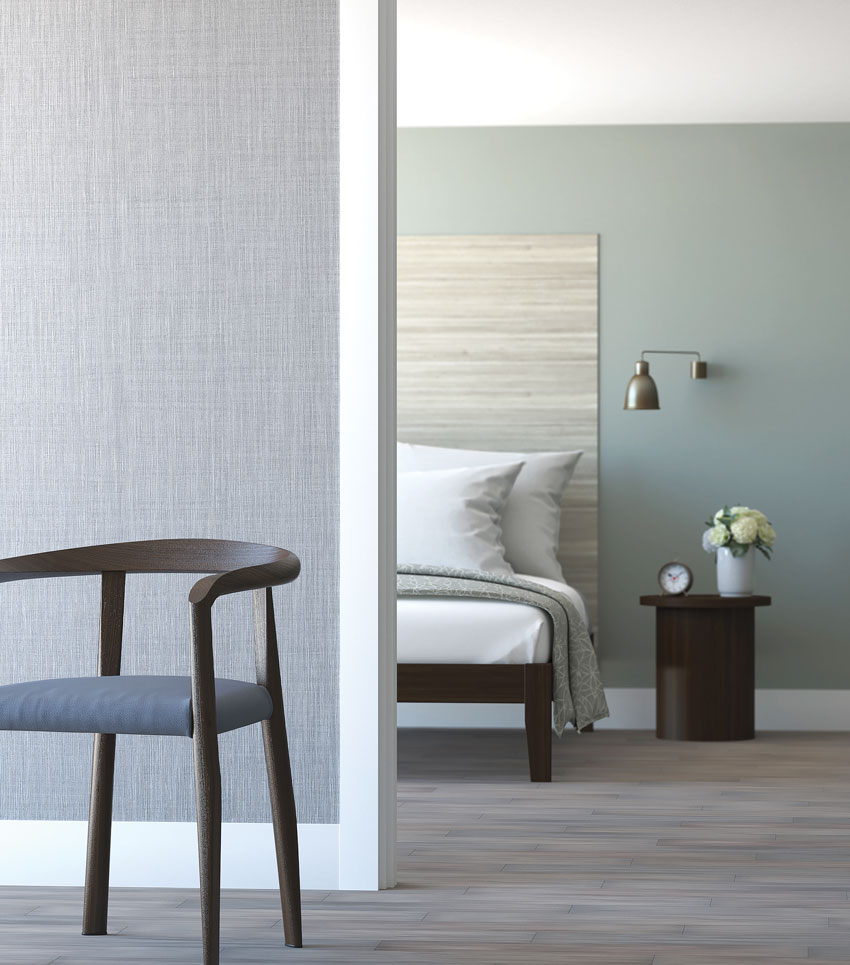
Photo courtesy of Inpro
Flexible wall protection can provide both the durability needed for long-term performance and the aesthetics and texture suitable to many interior design schemes.
Large-Scale Graphic Wall Protection
Wall surfaces in retail and hospitality buildings are commonly used to convey information through the use of artwork, graphics, or similar means. Just like any other wall surface, however, they need to hold up against heavy use, or even abuse, plus be easy to keep clean. To meet these needs, many architects are turning to wall-protection systems that also offer large-scale images that can be used to help promote a company’s brand, add an artistic flair to an interior, or incorporate custom imagery in strategic locations.
Wall-protection systems that incorporate such large-scale images are commonly made using clear, rigid sheet plastic with crisp digital imagery printed on the reverse side. This creates greater durability since the rigid sheet protects the image from scratches, dirt, and other hazards, including impacts from people, equipment, luggage, etc. The clear sheet also allows the surface to be cleaned regularly without affecting the graphic image.
From a design standpoint, the possibilities are virtually unlimited in terms of the colors and images that can be printed. Logos, mascots, mottos, advertising, beautiful artwork, or any other type of vibrant imagery is possible. Ultimately, the beauty of these systems is found in the way they help create a design feature that doubles as durable and easy-to-clean wall protection.
Where is it that these large-scale graphics would commonly be used? In retail entryways, dining rooms, cafeterias and similar spaces, the design is often all about the experience. Customers can be exposed to attractive interior graphics that can help bring them in the door and keep them coming back. Architects and interior designers can add beautiful scenery to walls to create an ambiance that sets the tone for a space, showcases best-selling products, or simply promotes a brand. In hospitality lobbies, guest rooms, and hallways, the last thing guests want is to open the door to a hotel room that does not feel welcoming. Adding beautiful scenery to walls using protected graphics can help ensure rooms are warm and inviting, and that guests feel comfortable.
The durability and suitability of such rigid wall protection with applied graphics can be assured by specifying products that meet recognized standards. Specifically, at a minimum, they should provide a Class A fire rating and meet ASTM F 476-84: System Impact Resistance and ASTM D 4060: Taber Abrasion Resistance. For locations that are subject to harsh conditions or where sanitation is a particular concern, they should also meet ASTM D-543: Chemical and Stain Resistance and ASTM G-21 & G-22: Fungal and Bacterial Resistance.
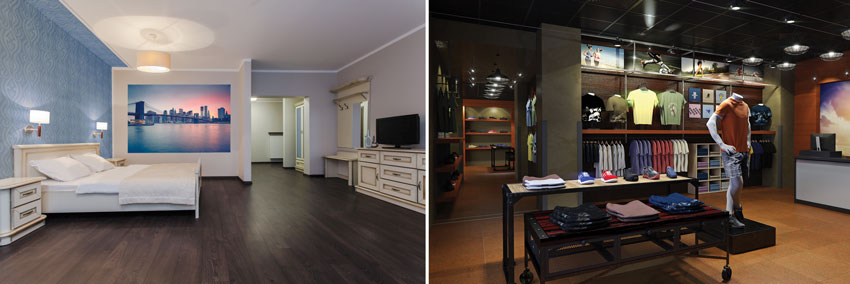
Photos courtesy of Inpro
Large-scale wall graphics can be used to enhance retail and hospitality spaces. When they are specified as part of a surface protection system, they will hold up over time and protect the wall beneath as well.
Elevator Renovation
Many retail and virtually all hospitality buildings include elevators either for convenience or to meet accessibility requirements. From a design standpoint, the cabs of these elevators should not be overlooked since it is a very real part of the user experience of many guests or customers. If addressed properly, they can be an integral part of the interior design of a facility with the integrity and durability to hold up to heavy use from people, carts, etc.
As an elevator is used over time, the cab interiors can get damaged, especially if they are used for both passengers and freight. Even under the best circumstances, dollies, bell carts, suitcases, freight, and furniture can gouge and scuff walls inside the elevator. The better way to address this potential damage is with protective wall panels and handrails that can resist these forces and keep the inside of the cab looking good.
In addition to needing protection, it is possible for the cab to simply look outdated over time just like any other interior scheme. Further, the lighting in an elevator cab needs to be adequate and maintained so that it doesn’t provide a dim, unattractive experience. Given these concerns, many designers are turning to preconfigured elevator cab renovation packages to breathe new life back into existing elevators or even starting out with them in new elevator cabs. Such packages can include new wall panels, ceiling grids and panels, handrails, and lighting. As a package, they can be coordinated to meet the demands for durability and the interior design scheme that is sought.
One critical aspect to bear in mind is that interior cab renovations often cannot be allowed to take the cab out of service for any extended period of time. Taking a cab down for renovation increases the potential for longer wait times, as the same number of passengers have fewer cabs to ride in. Ideally, then, cab renovation materials and processes should be designed to cut downtime to a bare minimum. Toward that end, modular renovation packages can be specified that allow for simple and easy installation.
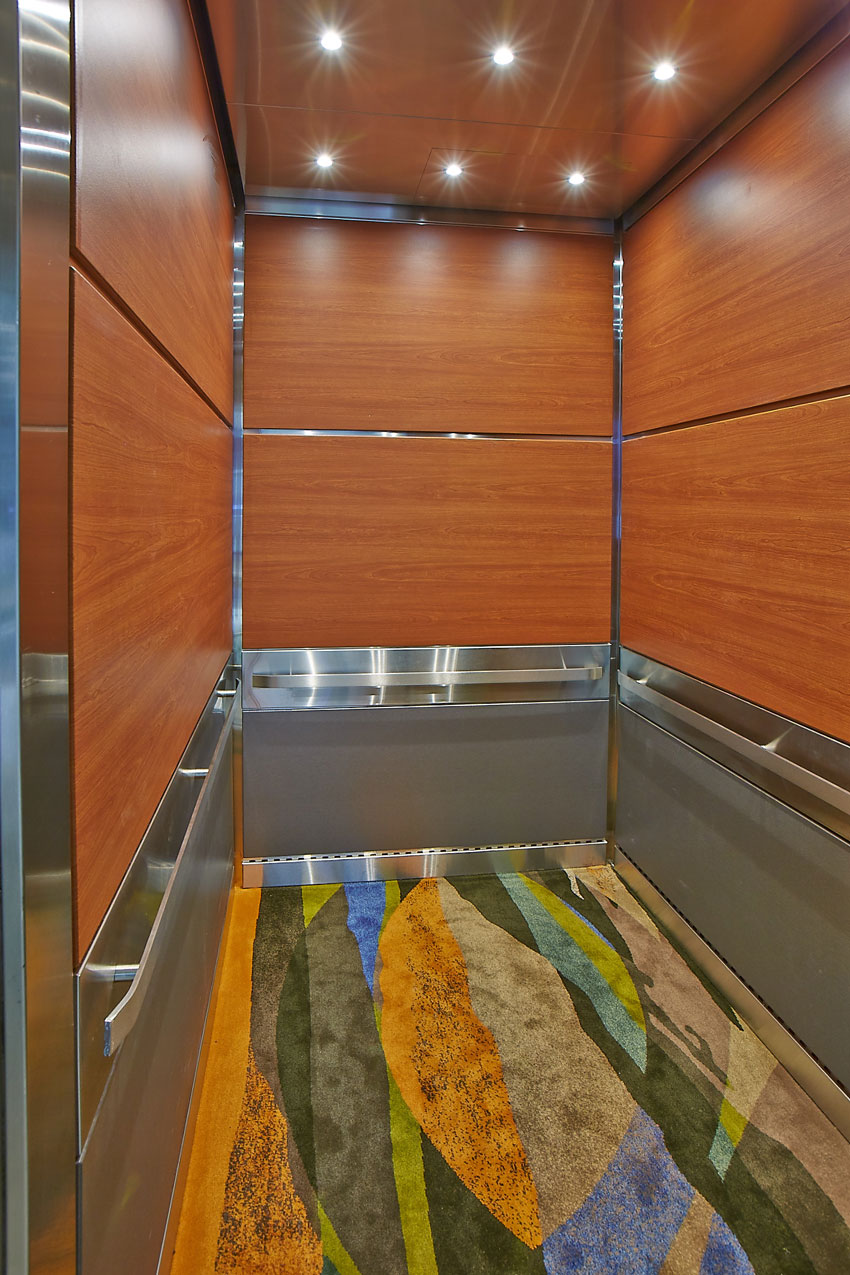
Photo courtesy of Inpro
Elevator cabs are part of interiors too. Using modular cab interior packages can provide a quick means to upgrade the interiors and provide protection against damage.
Innovative, Modern Wall Surfaces
Among the first surfaces that people experience in an interior space are the walls. They can be as simple and understated as white painted gypsum board or as elaborate and detailed as a designer’s imagination allows. All the while, they need to be easy to maintain and clean over the life of the building.
The trend in modern designs for retail and hospitality settings includes minimalist lines and the intentional absence of traditional moldings for doors, windows, ceilings and base conditions. With this in mind, many interior designs lean toward a simpler, more elegant wall-surface solution with a clean, modern look. Others select certain walls to feature with added detailing and trim to create a total appearance. Achieving any of these looks typically involves panels, of some sort such as gypsum board or other rigid materials with reveals or trim around the edges. That trim can be metal, wood, or other suitable choices to frame and accentuate a wall surface while protecting and aligning the panels.
Aluminum Interior Trim
One increasingly popular method of dealing with finish panels on wall surfaces is to use manufactured trim pieces made from aluminum extrusions. Standard products are readily available that are designed to be used with 5⁄8-inch-thick drywall to provide continuous edge protection. Similarly, aluminum trim can be used in conjunction with wrapped surface finishes, such as fabric or vinyl wall coverings. Such trim pieces are available in a variety of traditional, contemporary, and modern looks to create subdued, elegant aesthetics or emphatic three-dimensional appearances. Since aluminum is highly durable, recyclable, lightweight, and noncombustible, it is a popular and logical choice for interior trim of this type. Its strength helps provide some wall protection when used for corners and other areas that need some reinforcement. In that sense, it is a good example of a well-known material that can be used in innovative ways for interior designs.
Of course, the color of the trim is an important design consideration, regardless of the location. Fortunately, there are many options beyond the standard mill-finish aluminum coloring. Extruded aluminum trim can be specified to be finished with a paint primer only ready to receive final finish coats in the field of virtually any color. Alternatively, it can be specified as prefinished in the factory reducing the onsite labor needs. The standard prefinished choices vary by manufacturer but typically include durable powder-coat paint, conventional wet-paint coatings, or anodized aluminum in standard colors, such as clear, champagne, bronzes and black. At least one manufacturer can provide custom pattern matching on the aluminum to include logos, match wood panels or stone walls, or create a wood grain or even denim look. With this variety of choices, the trim can appear to blend in with the adjacent wall panels, or it can be used to highlight all or some of the visual lines it creates. This flexibility using familiar and long-lasting finish options means that both the design and the performance level can be controlled.
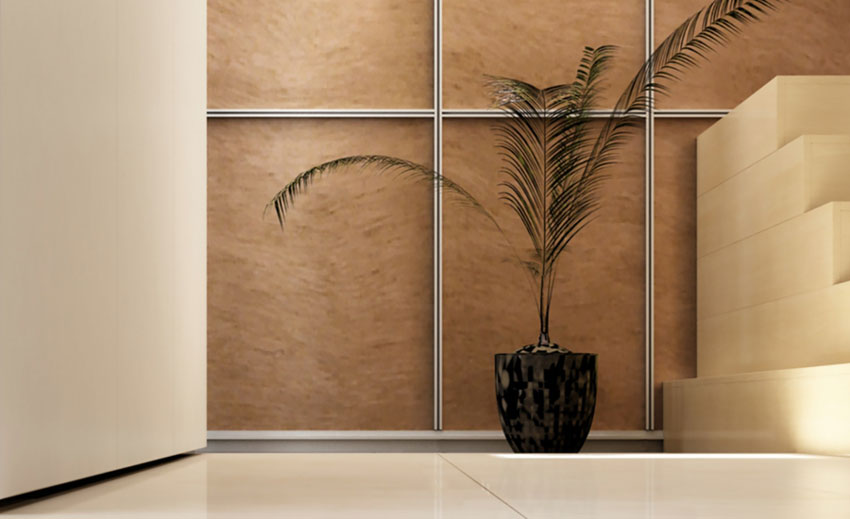
Photo courtesy of XtremeInterior by Tamlyn
Aluminum trim can be used very effectively to create interior wall designs that are durable and make strong visual statements.
In addition to standard trim products, custom profile shapes can be made quite affordably to accommodate not only particular styles but also to hold other materials such as glass, tile, panels, etc. in a variety of thicknesses. Some manufacturers offer customized service and designs to architects and will readily meet to discuss design ideas and solutions. They point out that if the trim profile can be drawn in a single line, it can probably be extruded. This service is not only centered on aesthetic issues but also on technical and performance issues of the trim related to its ability to perform and hold up over time. Dana Madden, product director with XtremeInterior by Tamlyn, reinforces this customized approach by saying, “The magic of aluminum is that the possibilities are endless. Everything from design, shape, size, color, finish, and temper to fit can be adjusted to meet the needs of each client/architect/designer.”
The unique design possibilities of using aluminum interior trim can create clean lines, shadow lines, or reveals that make a wall surface stand out as part of an interior space. It is also readily possible to create rounded corners, smooth transitions, or other shapes that enhance the overall design of the space in ways that wouldn’t be possible with traditional wall surfacing techniques.

Images courtesy of XtremeInterior by Tamlyn
Aluminum trim systems can create simple but stunning profiles for innovative wall surfaces. As shown here, they can provide flush base profiles that avoid interfering with furnishings yet still serve as protection for the lower edge of drywall.
Dan Brunn of Dan Brunn Architecture (DBA), Los Angeles, has worked with manufacturers on designs of this type and created some very successful interiors in the process. He notes, “Aluminum trim offers the perfect finishing solution for all of our modern building needs. I love the unique extrusions to create light pockets and that perfect reveal.” Designers like Brunn have also found that to be fully successful, a design needs to address all of the conditions and details of wall surfaces. That includes the wall base, corners, top edge, and any openings or variations. In that regard, they find that working with a single manufacturer who can provide all of the needed trim pieces in a coordinated system is a big key to success. Maybe just as importantly, being able to work out the details using a consistent and proven system means that innovation is possible without taking on undue design risk.
Retail and Hospitality Applications
Places that need to achieve good interior looks with a lot of durability, like retail and hospitality settings, quickly see the benefit of using extruded aluminum trim in conjunction with prefinished wall panels or site-finished gypsum board. For example, many fast-food restaurants often go through cycles of renovating and updating their locations to remain appealing to customers and competitive in the marketplace. The current trend among many of them, such as McDonald’s, Dunkin Donuts, Burger King, and others, is to move to a more sleek and modern motif, replacing some prior looks that are more visually cluttered and outdated in appearance. In the process, many are using prefinished wall panels with a selected wood grain or color as their primary wall surface. Then they are incorporating aluminum trim in coordinated finishes to provide durable corner and wall base conditions. They may also use aluminum trim pieces to create intentional reveals in the walls between the panels or at interior corners. Along the ceiling line, some incorporate an extruded aluminum trim piece that acts as a ceiling molding to complete the overall look and design intent.
Hospitality settings similarly require durability but may have a different aesthetic in mind. In these cases, extruded aluminum trim may be used with gypsum board to create defining lines along a wall surface or at the intersection of wall elements. Reveals are particularly popular in that regard and can be provided in a thin, minimalistic manner to simply reinforce vertical or horizontal lines, or to create an artistic accent on a wall. For a bolder, more three-dimensional profile, two-piece assemblies are available that allow a squared, rounded, or oblong shape to be inserted into a reveal that protrudes past the wall surface and creates a different shadow line and overall look.
Overall, extruded aluminum trim is an easy-to-install, logical solution for many interiors. It can be used as a stand-alone finished product or specified to have an edging to allow gypsum board tape and finishing compound that smoothly resolves into the surface of adjoining gypsum board. Either way, the designer is in control of the look, and with so many options of profiles, sizes, and colors available, the end result can enhance retail and hospitality settings of all types.
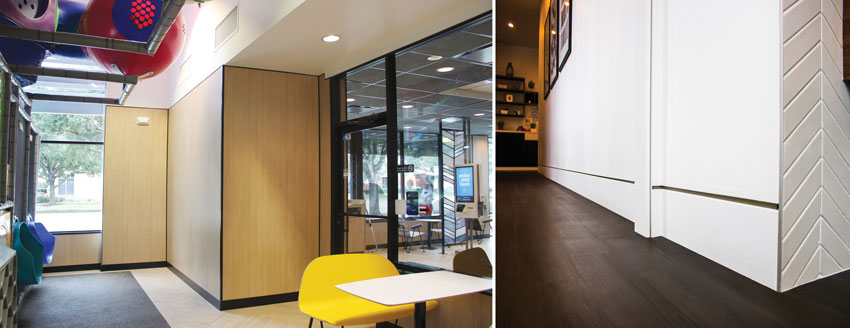
Photos courtesy of XtremeInterior by Tamlyn
Aluminum trim is shown here as used in fast-food restaurants (left) to provide clean, durable, and contemporary edging to wall panels. In hospitality settings (right), they can be used to blend with wall and base materials to establish an upscale, elegant look.
Designing Positive Restroom Experiences
One of the places that can make a significant impression on people, either positively or negatively, is the condition of the restrooms in a retail or hospitality facility. These restrooms often see a good amount of traffic, and it clearly wouldn’t be desirable to have them look like they were an afterthought or were neglected. A few consumer surveys reinforce this point:
- More than 80 percent of consumers would avoid a restaurant with a dirty restroom—not just avoid the restroom, but avoid the restaurant altogether (Zogby International).
- Eighty-six percent of U.S. adults equate the cleanliness of a restaurant’s restroom with the cleanliness of its kitchen (Harris Interactive poll).
- Seventy-five percent of U.S. adults would not return to a restaurant with dirty restrooms (Harris Interactive poll).
- Fifty percent of people who encounter a dirty restroom would discuss it with friends and family (Harris Interactive poll).
This data indicates that restrooms, quite significantly, tell the story of who an organization is and, more importantly, how it values the building’s occupants: customers, patrons, travelers, visitors, and even their own employees. It also reveals that restrooms can be a critical factor in a customer’s overall store or hospitality experience. The impression created seems to be that a clean restroom equals a clean building, or at least that a properly maintained restroom means that the owner and manager pay attention to details. More significantly for architects and designers, there is a sense that a well-designed restroom is equated to taking customers and their restroom experience seriously. By designing an excellent restroom experience, the impression created is that customers can trust the business to take care of them too.
Fortunately, designing bathrooms that enhance the user experience does not necessarily require much more money or thought than a poorly designed one—but they provide great dividends to the users and the business. Cyrus Boatwalla is head of marketing with ASI Group and has seen this firsthand, noting, “Bathrooms are impactful to the human experience whether in a hotel, casino, restaurant, retail chain, or entertainment complex. These establishments are often judged by the quality of their bathrooms, and that in turn can be the differentiating factor in how these businesses perform. Therefore, designers have the power to not only affect the human experience but also business outcomes.”
Given all of the above, we can look at three specific design elements that are being used to improve the way restrooms are responding to customer needs.
Behind-the-Mirror Accessories System
There are now modular mirror systems available that are designed for sophisticated, high-traffic bathrooms and provide an elegant, space-saving solution to the array of accessories and supplies common near bathroom sinks. This wall-mounted mirror cabinet conceals an automatic soap dispenser, and a choice of a paper towel dispenser or high-speed hand dryer, including some products that come with an included HEPA filter. The mirror is designed to swing upward to allow for servicing the dispensers and then close back down securely for general use. The modular construction allows architects to choose multiple configurations and mounting options. Backlit icons can be specified to be etched into the front of the frameless mirror, directing users to their choice of soap or drying option just below the mirror. From a safety standpoint, the self-contained design reduces hazards associated with wet floors when users need to walk with wet hands to a remote dryer or towel dispenser. The visual appeal of this cabinet design makes it ideal for creating sophisticated bathrooms, while the modular flexibility and dispensing capacity makes it ideal for hotels, shopping malls, entertainment centers, sport facilities and similar venues. The central location of supplies also makes it easy to service and maintain.
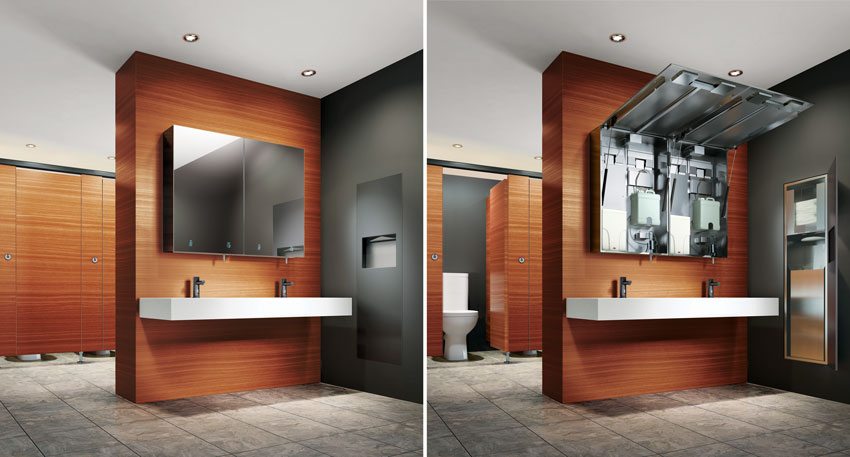
Images courtesy of ASI Group
Behind-the-mirror accessory systems provide a sophisticated and elegant solution for restroom designs that also make cleaning and maintenance very easy.
Restroom Accessories
It is common for restroom accessories such as recessed towel dispensers, trash receptacles, etc. to be made from stainless steel. At least one manufacturer, however, has created a bold new line of such accessories made from resilient phenolic. This heavy-duty and workable material offers several advantages. In terms of appearance, they are available in black or white to add an appropriate visual feature to the restroom design. Further, they are designed to create a fully flush appearance in the same plane as the surrounding wall with virtually no gap between the wall and cabinet door. From an integration standpoint, they are available in a variety of sizes and configurations to accommodate different space needs. For maintenance and servicing, the high-quality furniture style hinges are used instead of standard piano hinges, which means they hold up better over time. These hinges are adjustable in the field to ensure a proper fit and operation as needed. In all, they create a durable, elegant, and easily integrated restroom accessory solution for an upscale appearance that is cost-effective.
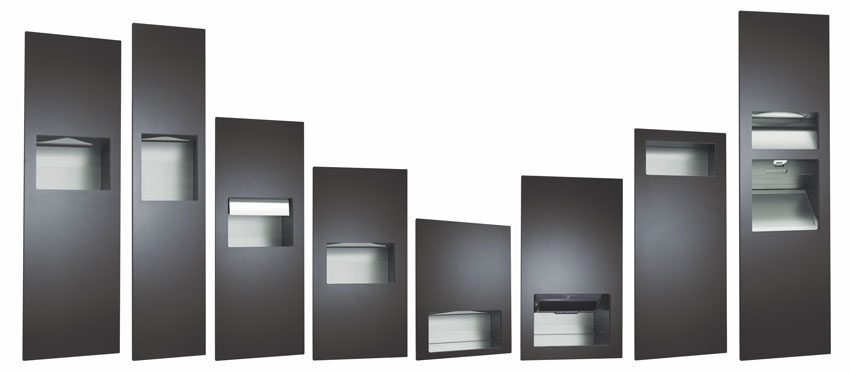
Images courtesy of ASI Group
A new class of restroom accessories has been designed to lie perfectly in the plane of the surrounding surface. Using black or white phenolic doors instead of the standard stainless steel, these accessories are available in a variety of sizes and configurations.
European-Style Full-Privacy Partitions
Elegant extra-height partitions are the norm in Europe and are catching on in the United States since they provide added privacy. The elegant design of these full-height partitions can accentuate the design of any restroom. For those who choose to incorporate the European-style partitions, there are manufactured products that combine dramatic lines, bold colors, well-designed hardware, and adjustable-height pedestals. Pedestals can be placed on the panels instead of the pilasters to give the partition stalls a floating look. Adjustable pedestals allow for field adjustment if floors are uneven. Generally seen as a marriage of simplicity and functionality, the European design is based on elegantly paying attention to privacy. Extended-height partitions and doors that are much lower to the floor and up closer to the ceiling (unlike common partitions that stop shorter of both) create zero sightlines for privacy assurance. The end result is a more substantial and sophisticated look that provides a better shared restroom experience.
It is important to pay attention to stall depths and any changes that may be needed in the European-style stalls that need to be ADA and accessibility compliant. That is fairly straightforward but needs the proper attention, of course. The other details of such partitions typically include design options and functionality choices, making them well suited to a full range of high-profile setting. Some styles create a more graceful and refined partition system. Elements such as steel top rails provide structural stability and style, while beveled edges can accentuate a refined appearance. Further, self-closing doors with elegant hardware create a clean look throughout the restroom even when unoccupied. Overall, these partitions can provide comfort and beauty with the strength and durability to keep them operating and looking good for years.
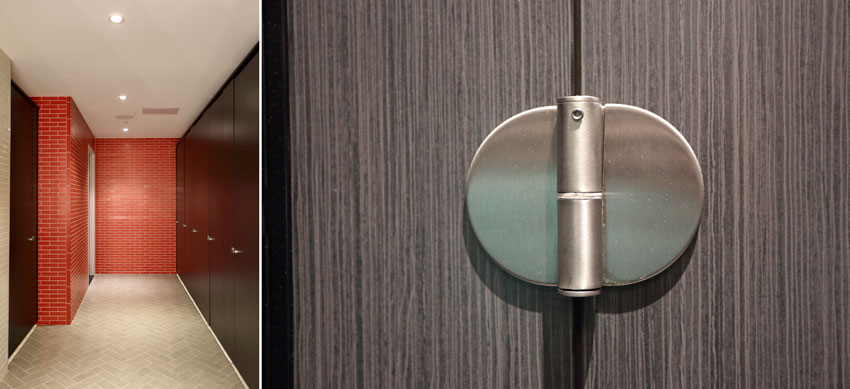
Photos courtesy of ASI Group
Full-height, European-style partitions and doors use elegant features and hardware to improve privacy and the overall appearance of restrooms.
These three design elements, whether used separately or together, help tell the story of a facility to its users. They improve the aesthetics dramatically without standing out by incorporating a “less-is-more” approach to design. They allow the architectural design to be the prominent feature instead of the products being used. The color palate is wide, and the visual impact they create can meet the dramatic styles of any building.
Conclusion
We have presented several ways that retail and hospitality design can be enhanced. Creating outdoor spaces adds vitality and attractive amenities to different venues. Incorporating opening glass walls helps connect indoor and outdoor spaces while offering thermal protection when needed. Interior wall surfaces can be protected while at the same time provide the option for graphics and artwork. Extruded aluminum interior trim can support a clean, durable, enhanced interior design. Restrooms that pay attention to the coordinated details of the design create positive user experiences that help the business aspects of the facility. Overall, design professionals have multiple tools at their disposal to tweak and improve the aesthetic and performance potential for retail and hospitality projects.




